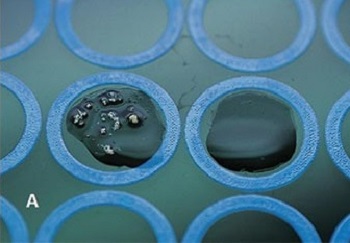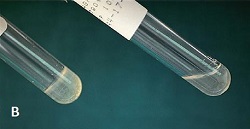Coagulase test - Introduction, Pathogenesis, Slide test, Tube test
Introduction to Coagulase test
Coagulase is a proteinous enzyme produced by several microorganisms which convert the host protein- fibrinogen to fibrin. The production of coagulase is tested to distinguish Staphylococcus species.
In a laboratory setting, it is mostly used to identify Staphylococcus aureus which shows a positive result. Although not all S. aureus is coagulase-positive, pathogenic strains of Staphylococcus aureus do produce the enzyme.
A negative coagulase test shows the test microorganism may be Staphylococcus epidermidis or Staphylococcus saprophyticus and is associated with opportunistic infection.
Another medically important pathogen that produces coagulase is Yersinia pestis, the causative agent of plague.
Pathogenesis of Coagulase test
Coagulase works by reacting with prothrombin present in the blood resulting in the formation of a complex called staphylothrombin. It in turn enables it to act as a protease to break down fibrinogen to fibrin which results in the clotting of the blood.
As coagulase is tightly bound to the bacterium, host fibrin can coat it, further protecting the pathogen from phagocytosis and other hosts immune responses. The fibrin coat can increase the virulence of the invading microorganism.
Types of Coagulase test
The coagulase test is used to differentiate Staphylococcus aureus from coagulase-negative Staphylococcus spp (CoNs). Staphylococcus aureus produces two forms of coagulase- free coagulase and bound coagulase aka clumping factor.
Bound coagulase/clumping factor- is bound to the bacterial cell wall and reacts directly with fibrinogen. Thus, fibrinogen precipitates on bacterial cells causing cells to clump when the bacterial suspension is mixed with plasma.
Free coagulase is an extracellular protein enzyme. It activates plasma coagulase-reacting factor (CRF) to form a coagulase-CRF complex. This complex reacts with fibrinogen to produce fibrin clots.
Free coagulase can be detected by the slide coagulase test while free coagulase can be demonstrated by the tube coagulase test.
Slide test
The slide coagulate test detects bound coagulase in Staphylococcus.
Procedure
The procedure for the slide coagulase test is as following:
Two drops of saline are placed on two slides each - labeled Test (T) and Control (C).
Using a sterile wire loop, wooden stick, or straight wire, the saline drops are emulsified with the test organism on the test slide.
A drop of fresh plasma is added to the test mixture and control slide and rocked gently for about 10 seconds
If macroscopic clumping is observed within 10 seconds with no clumping on the control drop, the test is positive
If no clumping is observed on both slides, the test is negative
If the slide coagulase test gives a negative result, a tube coagulation test must be performed for confirmation.

Fig: slide coagulase test left (right), right (left) (Source: Bailey and Scott’s Diagnostic Microbiology)
Tube test
The tube coagulase test detects free coagulase.
Procedure
Tube coagulase test can be performed by the following steps:
In a test tube, the test colony is added to 0.5ml plasma (mix well to give milky suspension)
The test tube is incubated at 35-37°C for 1.5 hours
If plasma coagulates, the clot is formed giving a positive result
In negative cases, plasma remains in liquid form.
Sometimes in positive cases, the clot in plasma is so pronounced, that the liquid solidifies.

Fig: tube coagulase test- positive (left), negative (right) (Source: Bailey and Scott’s Diagnostic Microbiology)
Coagulase test -positive staphylococci
A list of Coagulase-positive staphylococci are:
Staphylococcus aureus
Staphylococcus delphini
Staphylococcus hyicus
Staphylococcus intermedius
Staphylococcus lutrae
Staphylococcus schleiferi subsp. coagulans
Coagulase test -negative staphylococci (CoNs)
A list of Coagulase-negative staphylococci are:
Staphylococcus saprophyticus
Staphylococcus cohnii subsp. cohnii
Staphylococcus cohnii subsp. urealyticum
Staphylococcus captitus subsp. captitus
Staphylococcus warneri
Staphylococcus hominis
Staphylococcus epidermidis
Staphylococcus caprae
Staphylococcus lugdunensis